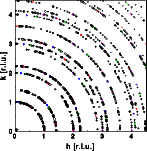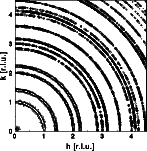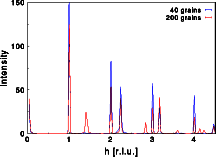Powder diffraction: powder pattern

Powder diffraction
Few crystals
Powder pattern
Preferred orientation
Pair distribution function
Interactive examples
PDF simulator
Goto
Contents



The left image above shows again the 2D diffraction pattern obtained from 40 grains. The corresponding trace along [h00] shown in the right image (blue curve) is quite different than we would have guessed. Some lines are completely missing. Our diffraction pattern was recorded with a stationary sample of 40 powder grains. These are too few grains to evenly cover the powder rings. The trace, cut at an arbitrary direction, suffers from insufficient statistics. In order to record a proper powder pattern, the sample should be rotated or more grains should be added. The middle image shows a 2D diffraction pattern obtained from 200 grains. The corresponding 1D trace along [h00] (red curve) shows a much better representation of the intensities. Still some of the reflections do not show the correct intensity.